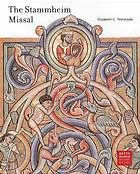Table Of ContentThe
Stammheim
Missal
THE S T A M M H E IM MISSAL
Hildesheim, probably 1170s
The Wisdom of Creation [detail]
(fol. 1OV)
The
Stammheim
Missal
Elizabeth C. Teviotdale
GETTY M U S E UM S T U D I ES ON ART
Los Angeles
Christopher Hudson, Publisher Cover:
Mark Greenberg, Managing Editor Initial A with David and Companion Musicians
[detail]. Stammheim Missal, Hildesheim,
Mollie Holtman, Editor
probably 1170s. Tempera, gold, and silver
Jeffrey Cohen, Designer
on parchment, 184 leaves, 28.2 x 18.8 cm
Suzanne Petralli Meilleur, Production Coordinator
(11 1/8 x 77 /16i n.). Los Angeles, J. Paul Getty
Charles Passela, Photographer
Museum, Ms. 64, fol. 12, (97.MG.21).
© 3001 The J. Paul Getty Trust. Frontispiece:
All rights reserved. The Wisdom of Creation [detail]. Stammheim
1200 Getty Center Drive Missal (fol. 10V).
Suite 400
Page vi:
Los Angeles, California 90049-1681
Saint Bernward of Hildesheim [detail].
www.getty.edu/publications
Stammheim Missal (fol. 156).
Library of Congress
The books of the Bible are cited according to
Cataloging-in-Publication Data
their designations in the Latin Vulgate.
Teviotdale, Elizabeth Cover All translations from the Latin are by the author.
The Stammheim Missal / Elizabeth C.
Teviotdale. Typography by G&S Typesetters, Inc.
p. cm.—(Getty Museum studies on art) Austin, Texas
Includes bibliographical references Printed in Hong Kong by Imago
ISBN 0-89236-615-x
1. Stammheim missal. 2. Illumination
of books and manuscripts, German-
Germany—Lower Saxony. 3. Illumination
of books and manuscripts, Medieval-
Germany—Lower Saxony. 4. Michaeliskirche
(Hildesheim, Germany) 5. Illumination
of books and manuscripts — California —
Los Angeles. 6. J. Paul Getty Museum.
I. J. Paul Getty Museum. II. Title. III. Series.
ND3375.S7 T48 2001
745.6 '7'o9435958o7479494-dc:21
00-062765
CONTENTS
1 The Stammheim Missal and the Artistic Heritage
of the Monastery of Saint Michael at Hildesheim
19 Observations on Early Medieval Mass Books
and Their Illumination
36 Jewish Scripture in Christian Art
of the Middle Ages
53 The Frontispiece Miniatures
66 The Feast Miniatures and Saints' Miniatures
82 The Pictorial Program
89 Summary Description of the Stammheim Missal
90 Glossary
93 Essential Bibliography
94 Acknowledgments
THE STAMMHEIM MISSAL
AND THE ARTISTIC HERITAGE
OF THE MONASTERY
OF SAINT MICHAEL AT HILDESHEIM
T
he Stammheim Missal is one of the supreme monuments of twelfth-
century art. A sumptuous religious service book, it was written and
decorated entirely by hand in the monastery of Saint Michael at Hildes
heim in northern Germany [FIGURE 1]. It remained in the collection of the
abbey from its creation, probably in the 1170s, until February 1803, when
the monastery was secularized. At that time, the missal came into the pos
session of the prince-bishop of Hildesheim and Paderborn, Franz Egon,
Freiherr von Fürstenberg (1737—1825). In the early twentieth century,
the manuscript came to be called the "Stammheim Missal" after the name of
the Von Fürstenberg family mansion north of Cologne [FIGURE 2] The
missal remained in the hands of the Von Fürstenberg family until 1997,
when the Getty Museum acquired it.
The Stammheim Missal owes its fame to the magnificence of the
painted decoration. The miniatures, initials, and decorated text pages, ex
quisitely executed throughout, are full of variety, yet harmonious in their
effect. The sheer beauty of the book's pages is matched by the theological
complexity of the illumination, especially as expressed in the full-page
miniatures. Indeed, the Stammheim Missal is an extraordinary art object
that makes a profound theological statement.
The first chapter of this book will introduce the manuscript, its
illumination, and the circumstances surrounding its creation. In the sec
ond chapter, the missal's painted decoration will be viewed with an eye to
1
Figure 1
Interior of the church
of Saint Michael,
Hildesheim, consecrated
1022. Photo: Foto
Marburg/Art Resource,
New York.
Figure 2
Schloß Stammheim,
Cologne.
Opposite
Figure 3
Scenes from the
Life of Christ. Column,
Hildesheim, circa 1020.
Bronze, H: 379 cm
(149V4 in.). Hildesheim,
cathedral. Photo: Foto the antecedent tradition of illuminated service books. The medieval his-
Marburg/Art Resource,
New York. tory of the representation of Jewish scripture in Christian art will then be
sketched, setting the stage for a scrutiny of the missal's full-page minia
tures in the next two chapters. The pictorial program as a whole is the sub -
ject of the final chapter.
The missal survives in its entirety except for its binding, which
has been replaced. The manuscript's illumination is remarkably well
2
preserved: the colors are as brilliant as the day the
paints were applied, the gold still sparkles, and most
of the silver remains untarnished. The missal owes its
exceptional state of preservation in part to having been
regarded even in the Middle Ages more as an object to
be treasured than as a book to be read and used.
Although we cannot know for certain, it seems that
five artisans—four writing the text and one providing
all the painted decoration—created the manuscript.
Its original binding was probably the work of yet
another craftsman. Most probably, all of these arti
sans were monks of the abbey.
The monastic community of Saint Michael had
been in existence for about 150 years at the time the
Stammheim Missal was created. Saint Bernward (died
1022), bishop of Hildesheim, founded the monastery
just outside Hildesheim's medieval city walls in the
early eleventh century The abbey church was built at
Bernward's behest, with the foundation stone laid by
him in 1010. The church—consecrated in 1022, the
year of Bernward's death—was richly outfitted with art
objects that the bishop commissioned especially for
it. The most imposing of the church's furnishings was
a cast-bronze column over twelve feet tall and covered
with scenes from the life of Christ [FIGURE 3]. The
column's appearance, with sculpted reliefs arranged
in a spiral, directly imitates the look of imperial
Roman columns carved to celebrate military victories.
The triumph commemorated by Bernward's column is
not earthly, however, but spiritual—Christ's triumph
over death—and the column was originally topped by
a cross.
3

